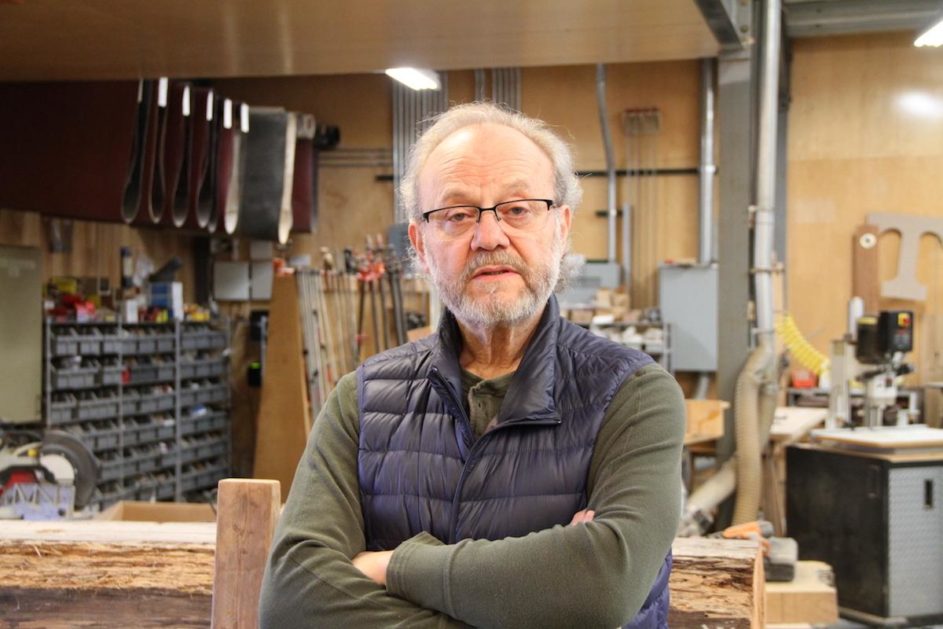When the Knoxville Jewish Day School decided to bring the Violins of Hope project to Knoxville and stage an exhibition as well as live performances of music on the restored violins played and owned by victims of the Holocaust, the logical place to turn to get the exhibition displays built was Ernie Gross Designs.
Gross was all in from the beginning. His mother had spent two years imprisoned in the concentration camp at Auschwitz. Liberation by Allied forces came just in time to save her. His father had been in labor camps.
After the war, his parents made a home in the farm village of Homok, Hungary, which became part of Romania. The family lived there until Gross was 13. Then the family went to Paris to await papers to immigrate to Toronto, Canada, where his mother’s brother lived.
Eventually they moved to New York, where Gross earned a degree in industrial design at Pratt Institute in Brooklyn.
During the summers of his college years, Gross went to the Catskills where he worked as a busboy in a resort hotel. There he met and fell in love with the beautiful young Pamela Hilomen, whose family was anchored in Oliver Springs, where her father had a car body shop and followed his passion for raising cock-fighting roosters.
After graduation from Pratt in 1971, Gross followed Hilomen to East Tennessee. His mother found out they were married when he went home and she noticed the impression of a ring on his finger. She initially wasn’t happy his new wife wasn’t Jewish. But Pam’s conversion to Judaism changed that.
Gross parlayed his design degree into a job at Miller’s Department Store doing display design. It turned into designing much of Miller’s new store at the new West Town Mall.
Along the way, he started designing and building cabinetry and furniture for friends. That expanded into enough business to open his own shop, Ernie Gross Designs.
“I started getting enough requests to make things when people couldn’t find exactly what they wanted, I thought about changing my studio name to Ernie Gross Designs of Last Resort,” he jokes now after a long and very successful career building things for many of Knoxville’s homes, as well as businesses and the University of Tennessee.
After many years located on Jackson Avenue downtown, following the great warehouse fire in February 2007, Gross moved his studio and shop to the family farm in Oliver Springs.

The Violins of Hope exhibition cases at the UT Downtown Gallery
So working with the Knoxville exhibit designer and architect Louis Emmanuel Gauci to work out the details of fabricating the exhibit cases for Violins of Hope: Strings of the Holocaust came second nature to Gross. They began working on the exhibition, which opened a week ago at the UT Downtown Gallery, in August.
How art and objects are exhibited is as critical to the success of telling the story of an exhibition as the objects themselves.
The resulting Violins of Hope exhibition space is configured roughly in the shape of a cattle car that the Nazis crammed people into to take them to the concentration camps. The front wall of the exhibition, intended to both set the tone of the show and block out the bright west sunlight that pours into the space, is designed to resemble the end of a cattle car with its black steel frame and rough-cut wood panels. Visitors enter the exhibition either to the left or to the right, the same way people were loaded onto the cars.
Inside the space, the violins are in individual cases that occupy roughly the space of a person, or in double cases, totally 27, the details and fabrication of which were Gross’s responsibility. To highlight the beautiful wood and finishes of the violins, the legs of the cases are also made of rough-cut wood, with the case itself of plain medium density fiberboard.
Gross found the violin mounts and designed the LED lighting that comes from the top of the case, hidden from the viewer, so the focus is on the instruments.
The exhibition space is lit only by the light from inside the display cases, creating a calm, reverent atmosphere in which the stories of the violins and their former owners can be told.

Nazi, “Hail Hitler,” inscription written on the inside of one of the violins during a repair in 1936
One of the most disturbing instruments on display is a violin that has been taken apart. Asked to work on the violin during the war, the German restorer wrote in pencil on the inside “Hail Hitler, 1936.” The devastating inscription wasn’t discovered until years later when the instrument underwent the current restoration.
Visiting this exhibition is a solemn and moving experience that often produces tears.
The Downtown Gallery is at 106 S. Gay St. It has special hours for the Violins of Hope exhibition. Admission is free. The gallery is open 11 a.m.-6 p.m. Monday-Friday, 10 a.m.-3 p.m. Saturdays and 1-4 p.m. Sundays. The exhibition runs through January 27.
The Knoxville Symphony Orchestra, with guest Hallerin Hilton Hill, will perform a “Violins of Hope: Strings of the Holocaust” concert at 7 p.m. Wednesday-Thursday, Jan. 23-24, at the Tennessee Theatre.

